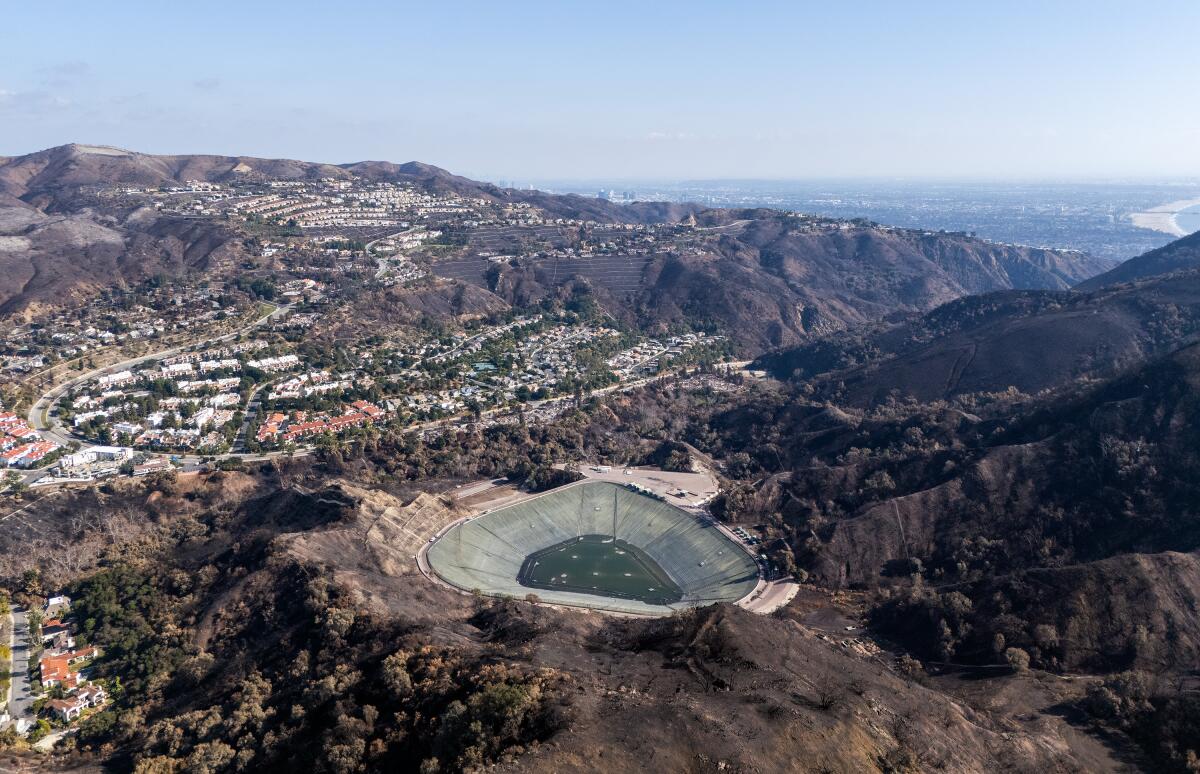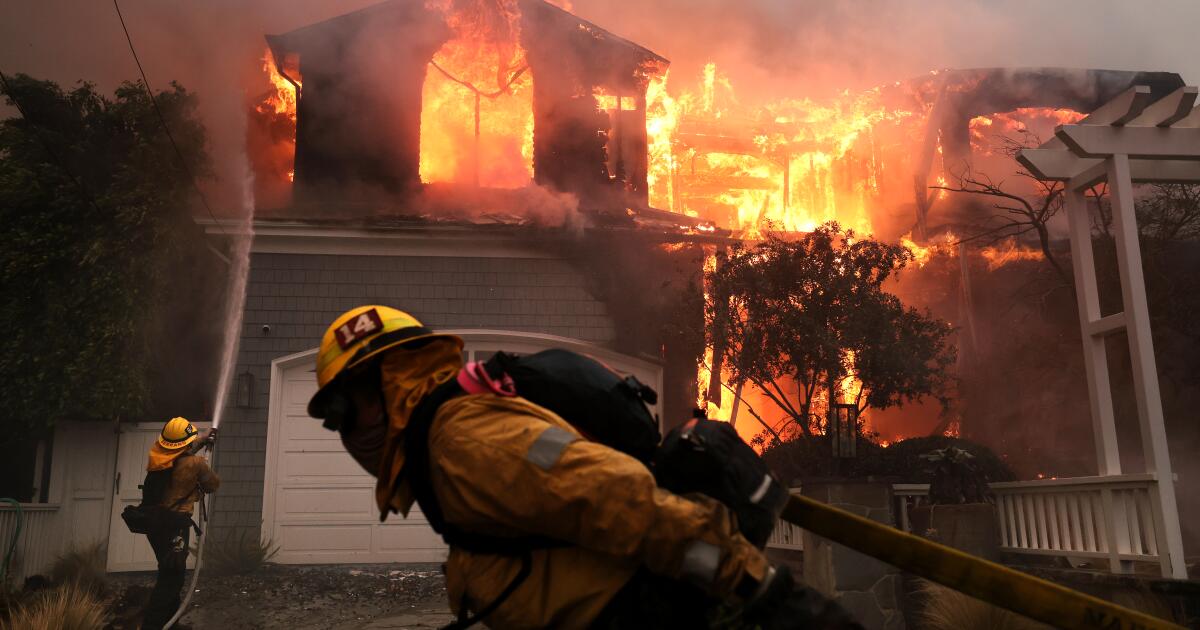Many in Pacific Palisades blame L.A. City Hall for fire failures. But can they win in court?
When federal prosecutors arrested a man Wednesday for setting a small fire that reignited days later into the deadly Palisades blaze, they suggested the arrest largely settled the matter of blame.
“A single person’s recklessness caused one of the worst fires Los Angeles has ever seen,” Bill Essayli, acting United States attorney for Central California, said as he announced the arrest of Jonathan Rinderknecht, a 29-year-old Uber driver.
But the new details they offered about the cause of the fire only added to residents’ anger and dismay about how city officials handled the fire that killed 12 people and destroyed more than 6,700 structures across Pacific Palisades and Malibu. It also renewed calls for City Hall to be held accountable.
The Santa Ynez Reservoir in Pacific Palisades was going through maintenance and empty during the Palisades fire. Photographed on Wednesday, Jan. 29, 2025.
(Myung J. Chun/Los Angeles Times)
Until this week, the focus of Palisades residents has been on a reservoir that was supposed to be a key source of water for the neighborhood being dry and other issues related to the fire response. But federal investigators concluded Wednesday that L.A. firefighters thought they had put out the small fire Rinderknecht allegedly set Jan. 1 only for it to smolder and burn underground and then rekindle in heavy winds Jan. 7.
This latest revelation is fueling debate over whether the city of L.A. or the state of California can be found civilly liable for its role in the fire.
Already, a flurry of complaints have been filed over the last 10 months accusing various L.A and California officials of failing to prepare for and respond to the fire.
Most legal experts agree that cases against government entities are tough because California law gives public officials broad immunity from failing to provide fire protection. Some argue that a criminal case against Rinderknecht could ultimately hurt residents’ civil complaints.
“Now those civil cases are dead in the water, because you have an arsonist,” said Neama Rahmani, president of the L.A.-based law firm West Coast Trial Lawyers, which is handling Eaton fire cases against Edison.
“That ultimately means that the already weak civil cases against the government became even weaker,” he said, “because now you have the person who’s really at fault for all this.”
EPA crews comb the ruins for hazardous material at a home on Miami Way, that was burned in the Palisades Fire, Thursday, February 6, 2025.
(Robert Gauthier/Los Angeles Times)
But lawyers suing the government on behalf of Pacific Palisades residents disagree, and maintain that Rinderknecht’s arrest does not undermine their case.
Just hours after federal law enforcement officials announced Rinderknecht’s arrest, attorneys representing thousands of Palisades fire victims filed a new master complaint against the city of L.A. and the state of California, plus about a dozen new defendants, including Southern California Edison, Charter Communications and AT&T.
“We never allege that the state or the city started the Palisades fire,” said Alexander “Trey” Robertson, an attorney representing 3,300 Palisades fire victims. Rather, he said, their case against the Los Angeles Department of Water and Power and the California Department of Parks and Recreation hinged on the lack of preparations in advance of the fire and the response after the fire started. “That has nothing to do with what started the Lachman fire,” he said. “It is what transpired after that fact.”
The 198-page complaint, filed in Los Angeles County Superior Court, was not a response to Rinderknecht’s arrest or the new details provided by federal prosecutors. Wednesday just happened to be the deadline a judge set for lawyers to file an omnibus complaint on behalf of 10,000 residents and business owners.
Robertson noted that his complaint did not include the Los Angeles Fire Department: California government code gives it broad immunity against claims of negligent firefighting.
But Robertson argued that the LADWP is liable, because the draining of the Santa Ynez reservoir resulted in fire hydrants running dry and their energized power lines came down on homes and vegetation that ignited additional fires. And the state of California is also liable, he said, because it did not inspect its land in the days between the Lachman and Palisades fires to ensure that no smoldering embers or residual heat remained that could reignite during the predicted Santa Ana wind event.
Robertson said there is case law that holds that a public entity is liable for a “dangerous condition” allowed to exist on its property that causes a fire.
“We allege that the embers from the Lachman Fire which the state allowed to burn for six days on its land (Topanga State Park) constituted a ‘dangerous condition of public property.’ This claim is expressly authorized by statute and not barred by the immunity statutes.”
Rahmani, whose law firm is handling cases against Edison in the Eaton fire, said that would be a very tough ‘dangerous condition’ case.
“What was the dangerous condition here that caused this fire?” he asked. “You’re saying the state has a legal duty. Think of all the hundreds of thousands of square miles of state parks in California to inspect the land. I don’t think any judge would say that there’s a legal duty to inspect forest land for smoldering fire.”
David Levine, a professor of law at UC San Francisco, said Wednesday’s arrest ultimately didn’t seem to change the limited liability public officials have in a fire through government immunity.
“It would be hard to prove liability on that because they’re going to have so much protection due to immunity,” Levine said. “Because these are public entities, they’re not going to be liable for punitive damages.”
Still, Levine said, plaintiff lawyers’ could try to thread the needle by using a ‘dangerous condition’ exception. “The statutes allow for that kind of a claim, but you have to prove it,” he said. “That’s a factual matter that would have to be developed.”
Rahmani said he always thought the cases against government entities in the Palisades fire were weak because California statute gives officials broad immunity from failing to provide fire protection.
“I personally feel that they’re leading people on, giving them hope that does not exist,” Rahmani said.
The emergence of a criminal suspect in the Palisades fire further hindered attorneys’ case, Rahmani said, because judges and juries tend to put all the fault on the criminal, even if there was a claim for negligence. “Because you have an intentional criminal act,” he said, “liability would have to be apportioned between the bad actors.”
Jurors, he said, already tended to be reluctant to put a lot of liability on government defendants. “They’re thinking, ‘Hey, my taxes are gonna go up, who’s gonna pay for all this?’.. That’s why it’s very hard to get massive verdicts against government entities.”
Asked about potential liability for the state or other jurisdictions in the Palisades fire resulting from the reignition of an earlier fire, California Gov. Newsom said, “We will look at the facts and judge on the basis of those facts.”
“When it comes to the issue of fire liability, I know a thing or two, going back to Paradise…” Newsom added. “This is done without political interference. The facts need to be pursued.”
Some lawyers expect that claims will be filed against Uber, Rinderknecht’s employer.
“Obviously, Uber is going to fight that,” Rahmani said. “In terms of someone to go after, Uber seems to me to be the only entity, and that’s gonna be a tough argument.”
Legal experts appear to agree on one thing: Even if Rinderknecht is convicted, he cannot possibly compensate the thousands of residents in the affluent coastal neighborhood of Pacific Palisades who lost loved ones and homes.
“I’ll assume he’s not an heir of Elon Musk or Estee Lauder,” Levine said. “The private and public loss is so vast here. Whatever assets this guy has, I would say, wouldn’t even qualify as a drop in the bucket.”
“Criminal justice — having someone be held accountable — is important,” Rahmani said. “But obviously, as far as money in the bank, it’s not going to be helpful.”
If an arsonist was found responsible in the Eaton fire, Rahmani said, that would have a huge impact on legal claims.
“That would be a home run for Edison,” Rahmani said. “That would save them and the California Fire fund billions of dollars, because then they wouldn’t be a fault. It wouldn’t be their tower. It wouldn’t be the electrical fire. This sort of arson with an accelerant, it would completely change the game, and the value of those claims would go to almost nothing.”
Times Staff Writer Daniel Miller contributed to this report

